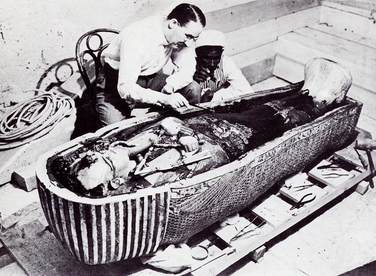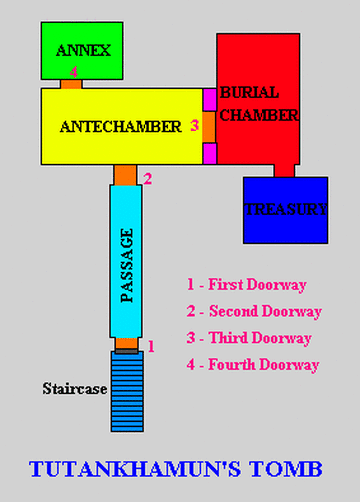The Discovery of Tutankhamun's Tomb
Tutankhamun's tomb is located in the Valley of the Kings and is by far the best preserved royal tomb ever discovered. This amazing archaeological find helped to reveal treasure beyond the wildest imagination. In fact, this grave site remained hidden for over 3000 years until a dedicated Egyptologist named Howard Carter began to search for a secret tomb after he uncovered clues written on other Egyptian artifacts. He started to dig in 1914, but was forced to delay his research until 1921 because of the outbreak of World War I.
The researchers began the project by digging close to the tomb of Ramesses VI. After working for a few days in the hot sun, he workers were told to remove an ancient workman's hut and found a step underneath. Carter quickly ordered the steps to be cleared and by the next day a doorway was revealed. Carter and his crew found a sealed door with Anubis standing above five defeated enemies and they soon realized it was the tomb of an ancient Egyptian pharaoh!
The archaeologists began to chip away at the door and soon there was a hole to peer inside. What they saw was one of the most amazing archaeological finds in history! The tomb was filled with countless treasures and the first royal Egyptian mummy to be found untouched since its burial.
The tomb of King Tut was much smaller than normal royal tomb, probably because it had to be prepared so quickly. It was 12 ft high, 25 ft wide and 101 ft long. The outer chamber was very disorganized and was covered with golden furniture and dismantled chariots. Deeper in the tomb, the annex was full of more golden furniture, chars of precious oils and ointments and also food and wine. Tutankhamun's tomb was not, as is commonly believed, untouched when it was found. Howard Carter believed it had been robbed twice shortly after the funeral. Only the burial chamber, where the mummy was located, was untouched. In reality, most of the small portable items included in the burial had been removed long before 1922.
The burial chamber contained the shrines and coffins of Tutankhamun including the fabulous solid gold coffin and the famous death mask. The death mask was made from solid gold and inlaid with lapiz lazuli, quarts, obsidian, turquoise and colored glass. Another room, the treasury, was guarded by a solid gold statue of the god Anubis and contained chests of priceless jewelry, model boats and the golden shrine which contained the canopic jars that housed Tut's internal organs.
Some of the other priceless treasures found in the tomb include bracelets, amulets, pendants, pectorals, rings, six chariots, couches, chairs, two thrones, daggers and other weapons, shields, lamps, musical instruments, vases, one hundred and thirty nine ebony, silver and golden walking sticks, ostrich feather fans, games like Senet, thirty jars of wine, perfume, oils and ointments.
Overall, However Carter found about 3,000 separate objects in Tutankhamun's tomb, many of which were pure gold. There were so many items there that he spent 10 years clearing and cataloging them before he died in 1939. Overall, Carter's hard work we may never have found Tutankhamun and the mysteries of Egyptian civilization would have stayed locked away forever.
The researchers began the project by digging close to the tomb of Ramesses VI. After working for a few days in the hot sun, he workers were told to remove an ancient workman's hut and found a step underneath. Carter quickly ordered the steps to be cleared and by the next day a doorway was revealed. Carter and his crew found a sealed door with Anubis standing above five defeated enemies and they soon realized it was the tomb of an ancient Egyptian pharaoh!
The archaeologists began to chip away at the door and soon there was a hole to peer inside. What they saw was one of the most amazing archaeological finds in history! The tomb was filled with countless treasures and the first royal Egyptian mummy to be found untouched since its burial.
The tomb of King Tut was much smaller than normal royal tomb, probably because it had to be prepared so quickly. It was 12 ft high, 25 ft wide and 101 ft long. The outer chamber was very disorganized and was covered with golden furniture and dismantled chariots. Deeper in the tomb, the annex was full of more golden furniture, chars of precious oils and ointments and also food and wine. Tutankhamun's tomb was not, as is commonly believed, untouched when it was found. Howard Carter believed it had been robbed twice shortly after the funeral. Only the burial chamber, where the mummy was located, was untouched. In reality, most of the small portable items included in the burial had been removed long before 1922.
The burial chamber contained the shrines and coffins of Tutankhamun including the fabulous solid gold coffin and the famous death mask. The death mask was made from solid gold and inlaid with lapiz lazuli, quarts, obsidian, turquoise and colored glass. Another room, the treasury, was guarded by a solid gold statue of the god Anubis and contained chests of priceless jewelry, model boats and the golden shrine which contained the canopic jars that housed Tut's internal organs.
Some of the other priceless treasures found in the tomb include bracelets, amulets, pendants, pectorals, rings, six chariots, couches, chairs, two thrones, daggers and other weapons, shields, lamps, musical instruments, vases, one hundred and thirty nine ebony, silver and golden walking sticks, ostrich feather fans, games like Senet, thirty jars of wine, perfume, oils and ointments.
Overall, However Carter found about 3,000 separate objects in Tutankhamun's tomb, many of which were pure gold. There were so many items there that he spent 10 years clearing and cataloging them before he died in 1939. Overall, Carter's hard work we may never have found Tutankhamun and the mysteries of Egyptian civilization would have stayed locked away forever.


